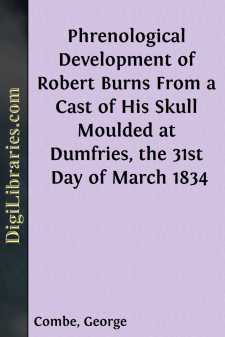Categories
- Antiques & Collectibles 13
- Architecture 36
- Art 48
- Bibles 22
- Biography & Autobiography 813
- Body, Mind & Spirit 142
- Business & Economics 28
- Children's Books 17
- Children's Fiction 14
- Computers 4
- Cooking 94
- Crafts & Hobbies 4
- Drama 346
- Education 46
- Family & Relationships 57
- Fiction 11829
- Games 19
- Gardening 17
- Health & Fitness 34
- History 1377
- House & Home 1
- Humor 147
- Juvenile Fiction 1873
- Juvenile Nonfiction 202
- Language Arts & Disciplines 88
- Law 16
- Literary Collections 686
- Literary Criticism 179
- Mathematics 13
- Medical 41
- Music 40
- Nature 179
- Non-Classifiable 1768
- Performing Arts 7
- Periodicals 1453
- Philosophy 64
- Photography 2
- Poetry 896
- Political Science 203
- Psychology 42
- Reference 154
- Religion 513
- Science 126
- Self-Help 84
- Social Science 81
- Sports & Recreation 34
- Study Aids 3
- Technology & Engineering 59
- Transportation 23
- Travel 463
- True Crime 29
Phrenological Development of Robert Burns From a Cast of His Skull Moulded at Dumfries, the 31st Day of March 1834
by: George Combe
Categories:
Description:
Excerpt
The cast of a Skull does not show the temperament of the individual, but the portraits of Burns indicate the bilious and nervous temperaments—the sources of strength, activity, and susceptibility; and the descriptions given by his contemporaries of his beaming and energetic eye, and the rapidity and impetuosity of his manifestations, establish the inference that his brain was active and susceptible.
Size in the brain, other conditions being equal, is the measure of mental power. The Skull of Burns indicates a large brain. The length is 8, and the greatest breadth nearly 6 inches. The circumference is 22¼ inches. These measurements exceed the average of Scotch living heads, including the integuments, for which four-eighths of an inch may be allowed.
The brain of Burns, therefore, possessed the two elements of power and activity.
The portions of the brain which manifest the animal propensities are uncommonly large, indicating strong passions, and great energy in action under their influence. The group of organs manifesting the domestic affections (Amativeness, Philoprogenitiveness, and Adhesiveness), is large; Philoprogenitiveness uncommonly so for a male head.
The organs of Combativeness and Destructiveness are large, bespeaking great heat of temper, impatience, and liability to irritation.
Secretiveness and Cautiousness are both large, and would confer considerable power of restraint, where he felt restraint to be necessary.
Acquisitiveness, Self-Esteem, and Love of Approbation, are also in ample endowment, although the first is less than the other two; these feelings give the love of property, a high consideration of self, and desire of the esteem of others. The first quality will not be so readily conceded to Burns as the second and third, which, indeed, were much stronger; but the Phrenologist records what is presented by nature, in full confidence that the manifestations, when the character is correctly understood, will be found to correspond with the development, and he states that the brain indicates considerable love of property.
The organs of the moral sentiments are also largely developed. Ideality, Wonder, Imitation, and Benevolence, are the largest in size. Veneration also is large. Conscientiousness, Firmness, and Hope, are full.
The Knowing organs, or those of perceptive intellect, are large; and the organs of Reflection are also considerable, but less than the former. Causality is larger than Comparison, and Wit is less than either.
The Skull indicates the combination of strong animal passions, with equally powerful moral emotions. If the natural morality had been less, the endowment of the propensities is sufficient to have constituted a character of the most desperate description. The combination, as it exists, bespeaks a mind extremely subject to contending emotions—capable of great good or great evil—and encompassed with vast difficulties in preserving a steady, even, onward course of practical morality.
In the combination of very large Philoprogenitiveness and Adhesiveness, with very large Benevolence and large Ideality, we find the elements of that exquisite tenderness and refinement, which Burns so frequently manifested, even when at the worst stage of his career. In the combination of great Combativeness, Destructiveness, and Self-Esteem, we find the fundamental qualities which inspired "Scots wha hae wi' Wallace bled," and similar productions....


